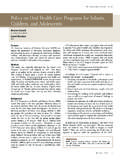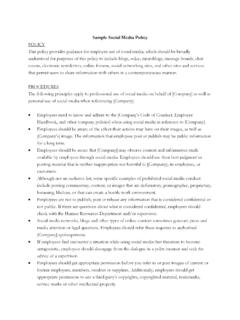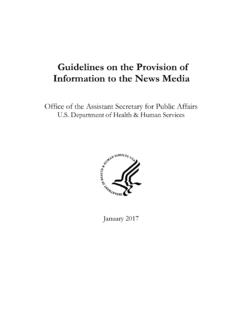Transcription of Policy on Early Childhood Caries (ECC): Unique Challenges ...
1 AMERICAN ACADEMY OF PEDIATRIC DENTISTRY. Policy on Early Childhood Caries (ECC): Unique Challenges and Treatment Options Review Council Council on Clinical Affairs Latest Revision 2016. Purpose processes. Approaches include methods that have been refer- The American Academy of Pediatric Dentistry (AAPD), to red to as: promote appropriate, quality oral health care for infants and 1. chronic disease management, which includes parent children with Early Childhood Caries (ECC), must educate engagement to facilitate preventive measures, and tempo- the health community and society about the Unique chal- rary restorations to postpone advanced restorative care;12.
2 Lenges and management of this disease, including the need 2. active surveillance, which emphasizes careful monitoring for advanced preventive, restorative, and behavioral guidance of Caries progression and prevention programs in chil- techniques. dren with incipient lesions;13 and 3. interim therapeutic restorations (ITR) that temporarily Methods restore teeth in young children until a time when tradi- This Policy was developed by the Council on Clinical Affairs tional cavity preparation and restoration is and adopted in 2000. This document is a revision of the previous version, revised in 2014.
3 The update used electronic Those children with known risk factors for ECC should and hand searches of English written articles in the dental have care provided by a practitioner who has the training and and medical literature within the last 10 years using the expertise to manage both the child and the disease process. search terms infant oral health, infant oral health care, and The use of anticariogenic agents, especially twice daily brush- Early Childhood Caries . Recent references to ECC, along with ing with fluoridated toothpaste and the frequent application full text, can be found on the Early Childhood Caries Re- of fluoride varnish, may reduce the risk of development and source Center database (http://earlychildhoodcariesresource progression of Caries .)
4 In some children where preventive ). When information from these articles programs are not successful, areas of demineralization and did not appear sufficient or was inconclusive, policies were hypoplasia can rapidly develop cavitation and, if untreated, based upon expert and/or consensus opinion by experienced the disease process can rapidly involve the dental pulp, lead- researchers and clinicians. ing to infection and possibly life-threatening fascial space involvement. Such infections may result in a medical emer- Background gency requiring hospitalization, antibiotics, and extraction of Epidemiologic data from a 2011-2012 national survey clearly the offending indicate that ECC remains highly prevalent in poor and near The extent of the disease process as well as the patient's poor preschool For the overall population of developmental level and comprehension skills affect the preschool children, the prevalence of ECC, as measured by practitioner's management decisions.
5 Definitive restorative decayed and filled tooth surfaces (dfs), is unchanged from treatment in young children, in many cases, can be postponed previous surveys, but the filled component (fs) has greatly by use of ITR or silver diamine fluoride For increased indicating that more treatment is being advanced cases of ECC, the practitioner may need the aid of The consequences of ECC often include a higher risk of new advanced behavior guidance techniques to complete the neces- carious lesions in both the primary and permanent denti- sary Also in such situations, stainless steel crowns tions,2,3 hospitalizations and emergency room visits,4,5 high often are indicated to restore teeth with large carious lesions, treatment costs.
6 6 loss of school days,7 diminished ability to interproximal lesions, and extensive white spot lesions since learn,8 and reduced oral health-related quality of Because restorative care to manage ECC often requires the use of sedation and general anesthesia with its associated high ABBREVIATIONS. costs and possible health risks,10 and because there is high AAPD: American Academy Pediatric Dentistry. ECC: Early child- recurrence of lesions following the procedures,11 there now hood Caries . ITR: Interim therapeutic restorations. is more emphasis on prevention and arrestment of the disease ORAL HE ALTH POLICIES 63.
7 REFERENCE MANUAL V 40 / NO 6 18 / 19. stainless steel crowns are less likely than other restorations to 9. Filstrup SL, Briskie D, daFonseca M, Lawrence L, Wan- require The success of restorations may be in- dera A, Inglehart MR. The effects on Early Childhood fluenced by the child's level of cooperation during treatment, Caries (ECC) and restorative treatment on children's oral and general anesthesia may provide better conditions to per- health-related quality of life (OHRQOL). Pediatr Dent form restorative procedures. General anesthesia, under certain 2003;25(5):431-40.
8 Circumstances, may offer a cost-saving alternative to sedation 10. Sinner B, Beck K, Engelhard K. General anesthetics and for children with the developing brain: An overview. Anesthesia 2014;69. (9):1009-22. Policy statement 11. Berkowitz RJ, Amante A, Kopycka-Kedzierawski DT, The AAPD recognizes the Unique and often virulent nature Billings RJ, Feng C. Dental Caries recurrence following of ECC. Non-dental healthcare providers who identify ECC clinical treatment for severe Early Childhood Caries . in a child should refer the patient to a licensed dentist for Pediatr Dent 2011;33(7):510-4.
9 Treatment and establishment of a dental Immediate 12. Edelstein BL, Ng MW. Chronic disease management intervention is indicated, and non-surgical interventions strategies of Early Childhood Caries : Support from the should be implemented when possible to postpone or reduce medical and dental literature. Pediatr Dent 2015;37(7): the need for surgical treatment approaches. Because children 281-7. who experience ECC are at greater risk for subsequent Caries 13. American Academy of Pediatric Dentistry. Guidelines development, preventive measures ( , dietary counseling, on Caries -risk assessment and management for infants, reinforcement of toothbrushing with fluoridated toothpaste), children, and adolescents.
10 Available at: http://http://. more frequent professional visits with applications of topical fluoride, and restorative care are necessary.. Accessed September 12, 2016. (Ar- References 6tjMFA5HL ).. chived by WebCite at: 1. Dye BA, Hsu K-L, Afful J. Prevalence and measurement 14. American Academy of Pediatric Dentistry. Policy on of dental Caries in young children. Pediatr Dent 2015;37 interim therapeutic restorations (ITR). Available at: (3):200-16. 2. O'Sullivan DM, Tinanoff N. The association of Early pdf . Accessed September 12, 2016. (Archived by Web- Childhood Caries patterns with Caries incidence in pre- school children.)
















